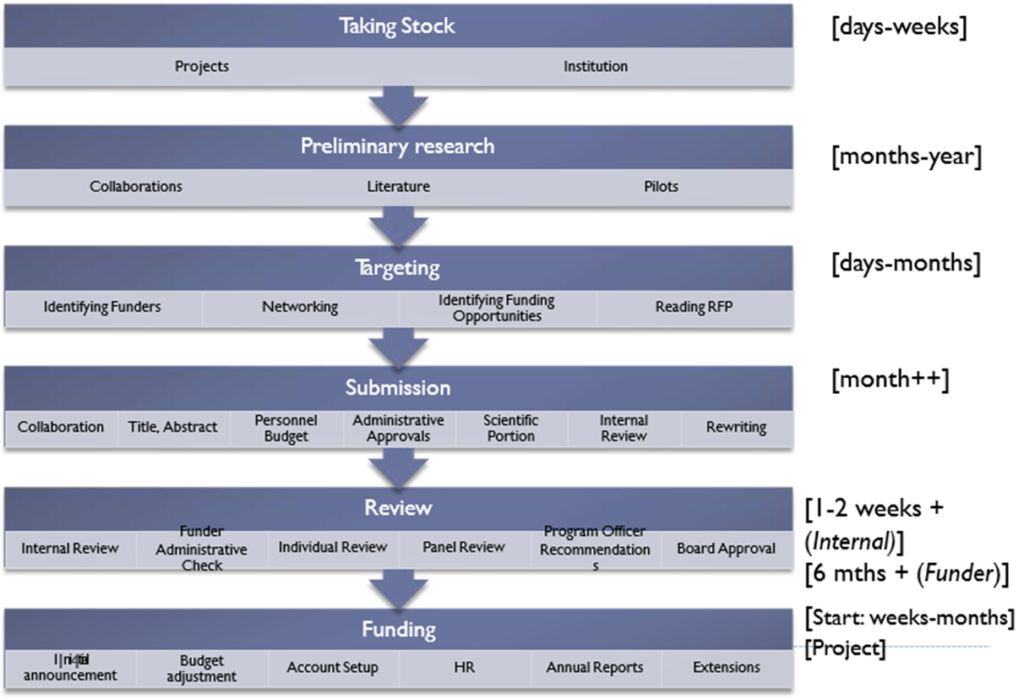Graduate students are mostly paid by research grants.
Faculty apply for funded projects; win some, lose some.
Four Steps for Finding Funding
- Develop an original idea for a research project that solves some part of an important problem
(bonus points for cleverness) - Do your homework – target a funder who is interested in that problem
- State the problem clearly for the reviewers:
- How it is important
- What you intend to do
- Why you chose to do that
- Be persistent, meticulous and systematic in writing submission and review
Different Types of Research Funding

Research Grants
Primary goal is scientific understanding
Peer-reviewed (in some way)
Wide discretion over objectives, methods
Judged retrospectively
Most technical
Most competitive*\
The “secret handshake”
Develop Professional Networks
Networks of colleagues to review proposals
Networks of collaborators for better projects
Networks of program officers
Referrals to other funders
Insights into peer review
Insights into funding priorities
Comments and feedback
Guiding Principles for Grant Funding
- Grants are rational agreements
- Harmonize funder mission, program goals, and project goals
- A successful proposal makes a compelling argument
- Reaching goals will make a great difference in areas about which the funders care deeply
- Project plan to each these goals is clear, thoughtful, firmly grounded: scientifically, financially, organizationally
- Project proposer (individual, group, institution) is well-prepared to carry out the plan
- Get Organized
- A successful proposal has many “working parts”, track each one
- Watch the calendar
- Collaboration requires extra time
- Write to facilitate review
- Above all, write clearly
- Address your writing to the reviewers: peer reviewer, program officer, and board
Timeline

What is a PI?
“Principal Investigator” (PI) Authority -> authority to take ultimate responsibility for the conduct of the research for the institution
- A PI may or may not be
- Primary author of the proposal
- Primary author of the resulting publications
- Primary person managing the project
- Other paid roles in a sponsored project
- Co-PI – responsible for some portion, usually paid
- Senior staff, paid
- Technical staff
- Student
- Postdoc
- Co-authorship is orthogonal
- Co-author on proposal and/or publications is possible w/out pay
- Co-authorship does not necessarily imply responsibility for conduct of project
Who funds science (in the US)?
- NSF, NIH, NEH
- DARPA, ARL, AFOSR, ONR, DTRA
- DNI, IARPA, CIA, NSA
- Dept of State, Dept of Justice, Dept of Homeland Security…
- Templeton, MacArthur
- Facebook, Google, Ford
- Alumni
How to Write a proposal
First: only write a proposal when you have an idea to propose. That idea/gap/”but” is of central importance.
State your central research question (and its sub questions)
Explain how it is important
Say what you plan to do (be realistic)
Say why you plan to do it (and how the literature supports it)
Example Full Proposal (as submitted to NSF)
Other materials support this:
References – support importance & the “why” of your plans
Bio – supports your ability to carry out the “what”
Budget, Timeline – supports the “what”
Example Budget (from Notre Dame – macros disabled)
NSF Review
Proposals are assigned to a panel.
Panelists are made of other researchers (who have not submitted to the same program, i.e., are not in conflict)
Panelists review proposals, identify strengths and weaknesses and assign E/V/G/F/P
Panel meets (usually physically in DC)
Makes recommendations. The recommendation looks like this:
[Before submitting, delete any text within the square brackets ] OVERVIEW OF THE PROPOSAL: [Enter first a brief description of the project, 2-4 sentences] INTELLECTUAL MERIT [List the salient strengths & weaknesses of IM] * Strengths * Weaknesses * Evaluation * Potentially transformative? BROADER IMPACTS: [List the salient strengths & weaknesses of BI, paying attention to the categories below] * Impacts on science and society: * Integration of Research and Education and Broadening Participation: RESULTS FROM PRIOR NSF SUPPORT (if applicable): DATA MANAGEMENT PLAN: [Brief evaluation] POST-DOCTORAL MENTORING PLAN (if applicable): [Brief evaluation or N/A] COLLABORATION (if applicable): DEPARTMENT CHAIR'S LETTER: HUMAN SUBJECTS (if applicable): BUDGET, FACILITIES (if needed): ADDITIONAL SUGGESTIONS: [Optional, this is where you can make constructive suggestions if applicable] Summary Statement: [Summary Statement textbox in Fastlane Review system: enter justification(s) for your rating, including key strengths and critical weaknesses. Here you should provide a brief synopsis of the strengths and weaknesses of the proposal and the reasons for your overall evaluation (i.e., the field is for a summary of your review, not a summary of the proposal itself). ]
How to Run a Research Lab
(If you have any good ideas let me know)